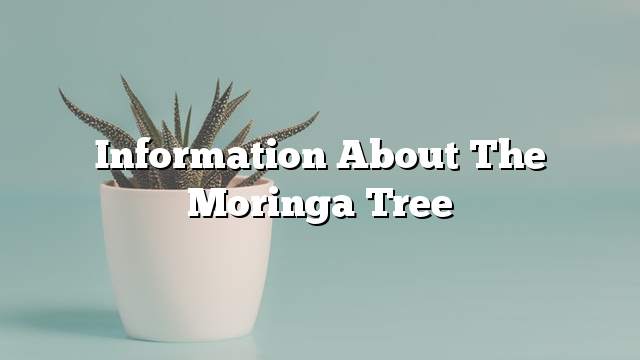Moringa tree
The Moringa tree is known as a small seasoned perennial plant. It dates back to tropical Asia, but then moved to tropical America and Africa. It has a length of about 9 meters. It also has a gray flax bark. Its leaves resemble the ferns. Aromatic collections of white flowers, the fruits of the corners resembling the daggers, it may grow to a length of about 45 cm, the possibility of cooking and eating flowers, and horns, and leaves, and even branches.
General information about the Moringa tree
There is some additional information about the Moringa tree, including:
- It is used to treat both constipation, cancer, anemia, high blood pressure, arthritis and other joint pain such as rheumatism, asthma, diabetes, epilepsy, headaches, kidney stones, stomach pain, gastrointestinal ulcers, intestinal cramps, heart problems, , Thyroid disorders, and bacterial, fungal, viral and parasitic infections, using their leaves, flippers, flowers, fruits, seeds, and roots.
- It can be used to relieve swelling, increase the production of breast milk, increase sexual stimulation, in addition to contraception, strengthen the immune system. Moringa can also be placed directly on the skin as a bactericidal agent or as a desiccant. It is used topically to treat gingivitis, snake bites, Sinus infection, athlete’s foot disease, and some people use it as a supplement or dietary tonic.
- Moringa seed oil is used in hair care products, in lubricants in machinery, in foods, and in perfumes.
- Moringa is an essential source of food in some parts of the world, because it can be grown easily and at low cost, as well as leaves on many vitamins and minerals when dried. Moringa is used in nutrition programs to combat malnutrition in India and Africa.
- The green meringue pods can be cooked and prepared by following the steps of preparing the green beans. The seeds are removed from the pods, then cooked like peas or preserved like nuts. The leaves are cooked like spinach leaves and can be used as spices. Dry and rub.
Health Benefits of Moringa Tree
There are several benefits to the Moringa tree, including:
- To promote hair growth and maintain it, and reduce its fall; because it contains a high proportion of vitamin A, which contributes to the vitamin in the healthy growth of cells, so the lack of this vitamin causes dry hair, the appearance of the crust, in addition to the thickness of the scalp.
- Moringa contains vitamin E, a powerful antioxidant, and stimulates blood circulation around the scalp. The proper flow of blood to the scalp helps absorb more nutrients in hair follicles.
- The Moringa tree has anti-aging properties and excellent cleansing properties. It helps restore skin vitality and youth, as well as cleaning the skin cells from the free radicals in human skin, reducing the appearance of wrinkles.
- Moringa seeds contain 40% odorless edible oil. It is rich in antioxidants, its nutritional properties are similar to olive oil, and it has an unlimited shelf life.
- Moringa leaves contain three times the amount of iron found in spinach.
- Moringa leaf extract is used as a preservative for food. It increases the shelf life of meat by reducing oxidation processes.
- Moringa is a rich source of antioxidants, compounds that work against free radicals in the body. The large amount of them cause increased oxidative stress, which can contribute to the emergence of chronic diseases such as heart disease and type 2 diabetes. A study showed that women who ate about one tablespoon And half a day of Moringa leaf powder for three months, increases their blood levels of oxidation significantly.
- Many antioxidant plant compounds have been found in Moringa leaves, which include quercetin, a powerful antioxidant that helps lower blood pressure, as well as chlorogenic acid, which helps to balance blood sugar levels after ingestion. the food.
